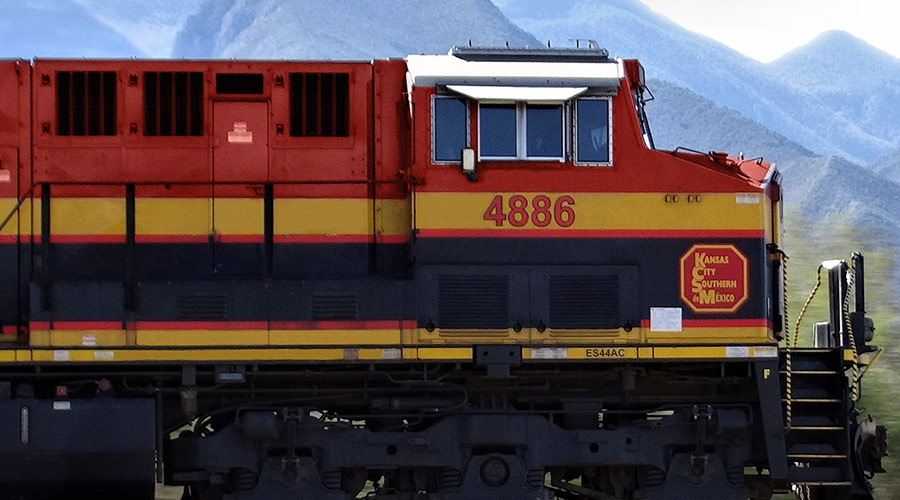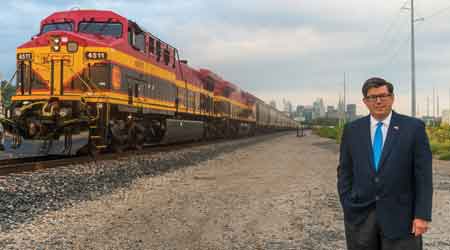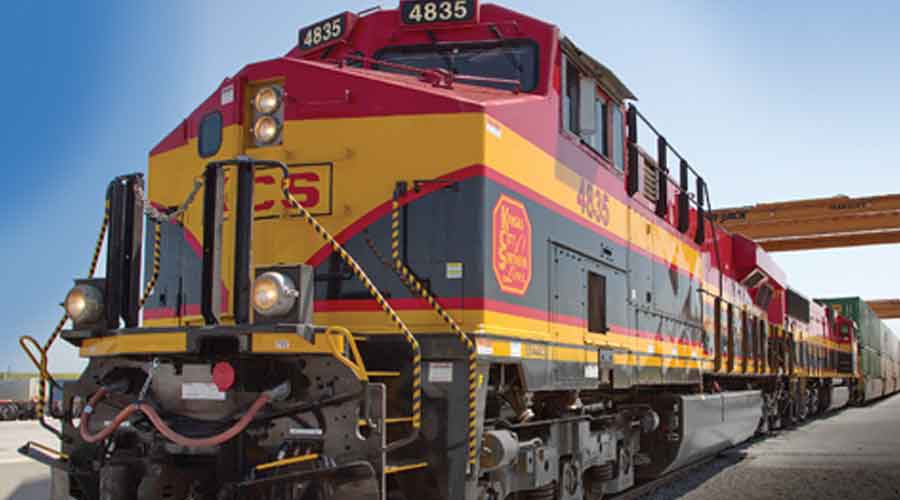Stay updated on news, articles and information for the rail industry
 railPrime
railPrime
September 2014
Rail News: Kansas City Southern
Automotive-related traffic a growth driver at Kansas City Southern
— by Angela Cotey, senior associate editor
On July 18, Kansas City Southern reported new revenue and carload records in the second quarter. Revenue jumped 12 percent to $650 million and carloads climbed 7 percent to 573,600 units compared with second-quarter 2013 figures. Both figures are record quarterly highs for KCS.
Volume and revenue increases in the railroad's five growth areas — which include automotive and cross-border intermodal — drove the second-quarter gains. And KCS officials don't expect growth in those segments to slow anytime soon, particularly in the automotive sector, which includes finished vehicles and vehicle parts.
Auto manufacturers have built more plants in Mexico in recent years, and KCS has access to most of them via Kansas City Southern de México S.A. de C.V. (KCSM). Three more plants are under construction or in the planning stages, and announcements for additional facilities are expected in the near term, said KCS Executive Vice President of Sales and Marketing Patrick Ottensmeyer during the railroad's second-quarter earnings teleconference.
"Our new business pipeline continues to be strong and growing, and we still feel very good about our long-term growth prospects," he said. "Based on new auto plants in Mexico, we have extended the period of expected superior growth in automotive beyond 2018."
Why Mexico? Mexican government officials have been focused on creating a more skilled workforce; today, more than 90,000 engineers graduate from higher-education institutions each year, according to an Automotive & Nearshoring presentation KCS officials use to describe the growth in the railroad's auto segment.
In the meantime, labor costs are on par with those in China, and by 2015, wages in Mexico are forecast to be 30 percent lower than those in China. In addition, Chinese products have become about 60 percent more expensive (in U.S. dollars) than those sourced in Mexico, according to the presentation.
Combine those factors with Mexico's free trade agreements — 14 of them involving more than 45 countries — and the country has become an attractive option for manufacturers seeking to build new plants.
The workforce, labor and trade factors have led to a "nearshoring" trend that brings production closer to the point of use; since 2010, U.S. imports from Mexico have risen 23.5 percent. Count automotive manufacturers among the parties interested in shifting more production to Mexico.
"The United States has the largest auto market in the world; for transportation costs and sheer logistics alone, there is an advantage for these manufacturers to be located in North America versus Asia," Ottensmeyer said during a recent interview with Progressive Railroading.
Mexico currently is ranked as the eighth-largest vehicle producer in the world, up from 10th-largest in 2009, says KCS Vice President of Automotive Kelley Anderson. The country has nearly doubled production output from 1.5 million units in 2009 to about 3 million in 2013, Anderson added. Given the number of plants that are scheduled to open soon, the Mexican Automotive Industry Association predicts that by 2020, Mexico may surpass South Korea and Brazil to become the sixth-largest worldwide vehicle producer.
New auto plants opening in Mexico
In February, Mazda opened a new plant in Salamanca, Mexico, that's expected to produce up to 230,000 vehicles annually. Once the plant reaches full production by March 2016, about 30 percent of the Mazda vehicles sold in the United States will be sourced from
North America, compared with virtually none today, according to an article posted on autoweek.com.
Also in February, Honda began production at a plant in Celaya that's expected to build 200,000 vehicles annually, about 80 percent of which will be sold in the United States and Canada, according to an article posted on autonews.com.
KCS serves the two plants that recently opened, as well as 10 other Mexican auto facilities. In the second quarter, the Class I's automotive carloads jumped 23 percent and automotive revenue spiked 25 percent compared with second-quarter 2013's totals.
Meanwhile, Audi plans to build a new production facility in San Jose Chiapa with a production capacity of 173,000 vehicles per year. The plant is scheduled to open in second-quarter 2016.
In 2017, Mercedes Benz/Infiniti expects to open an Aguascalientes plant under a co-production agreement with Nissan. The facility will have a production capacity of 300,000 units. And in 2019, BMW plans to open a facility in San Luis Potosi with an estimated production capacity of 150,000 vehicles.
KCS will have access to all three new facilities. And while it's too soon to say how the new plant openings might impact the railroad's volume, revenue and routing, it's safe to say KCS will capture at least some portion of the business, Ottensmeyer says.
As a result of the new plants coming on line and the production forecasts, finished vehicle production in Mexico is expected to increase from 3.2 million units in 2014 to 4.3 million in 2019, he added.
KCS' automotive sector isn't the only traffic segment benefitting from the plant-building boom. The railroad also has noted strong growth in its auto-related business, which includes the raw materials used to manufacture vehicles — steel, soda ash, scrap metals, industrial sand, tires, chemicals and more.
"In our case, for every dollar of revenue we generate moving the finished vehicle, we generate about another dollar moving parts or materials," says Ottensmeyer. "For us, the auto business as a whole represents about 16 to 18 percent of our total revenue, and that market is expected to grow 40 percent in the next five years. So that leaves us feeling pretty good about our growth profile."
Especially because KCS has carved its niche as a cross-border railroad. In 2005, the Class I decided to gain sole control of TFM S.A. de C.V., which was formed after KCS and Grupo TMM acquired Mexico's Northeast Railroad in 1996. Having control of the line, which is operated by KCSM, enabled KCS to transition from more of a regional U.S. railroad to a multi-national railroad. And in the years since the takeover, KCS officials have worked to develop a cross-border strategy, says Ottensmeyer. Prior to that, KCS and TFM were operated as "two independent carriers that happened to connect at Laredo [Texas]," he adds.
Expanded length of haul, expanded opportunities
By more aggressively marketing it's cross-border network — and one that can move products from Mexico to gateways such as Kansas City, Mo., where the railroad interchanges with BNSF Railway Co., Union Pacific Railroad, Norfolk Southern Railway and Canadian Pacific — KCS has differentiated itself from the competition, namely trucks and UP, which interchanges at Laredo.
"The infrastructure in Mexico relative to the privatization of the railroad has convinced a lot of manufacturers they can move products into and out of Mexico with a lot better opportunity than before," says Anderson. "And we're working to establish a longer length of haul to better use the attributes of our cross-border network."
Meanwhile, KCS leaders continue to foster relationships with the railroad's auto supply chain partners.
"We just moved the responsibility for the auto intermodal business from the intermodal group to the automotive group, recognizing that the owner of the freight and the company that's going to make decisions about routing of service is the auto company,"
Ottensmeyer says. "It's been helpful in terms of facilitating discussion with the ultimate customer."
KCS execs are using those connections to talk to OEM customers about diverting over-the-road traffic, including auto parts, to intermodal.
The Class I will have an opportunity to expand its intermodal business for automotive parts and other products in 2016, when the Port of Veracruz expansion is expected to be completed, says Anderson. The port is building extensive rail infrastructure as part of the project.
"It will allow for better access and higher equipment velocity, and give us an opportunity to reach a market inside Mexico that we haven't truly penetrated yet," he says.
More capex to help handle auto traffic growth
As automotive traffic volumes increase, KCS, too, will need to invest in capacity expansion. In recent years, the railroad has built state-of-the-art facilities and upgraded infrastructure through partnerships with asset and supply chain managers. Going forward, KCS will continue to invest in dedicated automotive facilities, as well as track, yard and siding expansions. The Class I also will need to add locomotives and rail cars to handle the growth.
"The one thing we think we'll have to get more aggressive on is locomotives — we have to have power," said KCS President and Chief Executive Officer David Starling during the earnings conference, speaking in general terms rather than automotive sector-specific. "We have to be cautious that we are not a victim of not having enough locomotives to take care of our own system."
While KCS officials did not note any automotive-related locomotive purchases or capital projects, they did state during the earnings teleconference that the railroad plans to spend about 28 percent of its total revenue on capex in 2014; that figure is up from 21 percent of total revenue set aside in 2013.
"We'll continue to spend ahead of the growth so we're in position to expand automotive business in the U.S. and Mexico," says Ottensmeyer.


 2025 MOW Spending Report: Passenger-rail programs
2025 MOW Spending Report: Passenger-rail programs
 Gardner steps down as Amtrak CEO
Gardner steps down as Amtrak CEO
 Guest comment: Oliver Wyman’s David Hunt
Guest comment: Oliver Wyman’s David Hunt
 Women of Influence in Rail eBook
Women of Influence in Rail eBook








